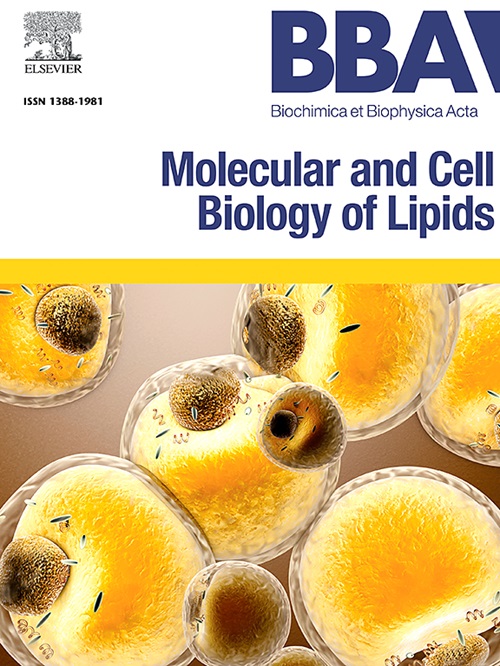磷酸肌肽酰基链多样性:跨物种和小鼠组织的比较分析。
IF 3.3
2区 生物学
Q2 BIOCHEMISTRY & MOLECULAR BIOLOGY
Biochimica et biophysica acta. Molecular and cell biology of lipids
Pub Date : 2025-05-28
DOI:10.1016/j.bbalip.2025.159640
引用次数: 0
摘要
细胞为其磷酸肌肽(PIPn)池创造了不同于其他磷脂类的酰基链组成物。虽然一些低级真核生物表现出高度异质的PIPn(例如,酵母,苍蝇),但更复杂的生物通常表现出在较少分子物种中富集的PIPn(例如,鱼,青蛙和小鼠中的C38:4物种)。对小鼠组织的综合分析(使用LC-MS/MS和MSI)证实了C38:4-PIPn的普遍富集,但也强调了几个具有显著不同酰基链组成的细胞群体的存在,其特征是更短链,更饱和的物种(例如,睾丸中的C32:0和前列腺中的C34:1)。驱动这些特定酰基链组成形成的进化压力尚不清楚;目前的证据表明,在不同的细胞类型中,PIPn作为膜捕获的“信使”所施加的生物物理限制(例如,在不同的膜环境中头部群呈现的灵活性),对大量从头脂质合成的需求(例如,在快速的膜扩张中),酰基链重构的需求(例如,在功能池的分子分离中)和脂肪酸可用性之间可能存在平衡。此外,在大多数体外细胞培养条件下,这种平衡将不可避免地被扭曲。本文章由计算机程序翻译,如有差异,请以英文原文为准。
Phosphoinositide acyl chain diversity: comparative analysis across species and mouse tissues
Cells create acyl chain compositions for their phosphoinositide (PIPn) pools that are distinct from other phospholipid classes. While some lower eukaryotes present highly heterogeneous PIPn (e.g., yeast, fly), more complex organisms typically display PIPn enriched in fewer molecular species (e.g., the C38:4 species in fish, frog and mice). A comprehensive analysis of murine tissues (using both LC-MS/MS and MSI) confirms a general enrichment for C38:4-PIPn but also highlights the existence of several cell populations with strikingly divergent acyl chain compositions, characterised by the prevalence of shorter-chain, more saturated species (e.g., C32:0 in the testes and C34:1 in the prostate). The evolutionary pressures driving the creation of these specific acyl chain compositions are still unclear; current evidence suggests there is probably a balance to be achieved in different cell types between the biophysical constraints imposed by PIPn as membrane-captive ‘messengers’ (e.g., flexibility in head group presentation in different membrane environments), the demand for substantial de novo lipid synthesis (e.g., in rapid membrane expansion), the need for acyl chain remodelling (e.g., in molecular segregation of functional pools) and fatty acid availability. Moreover, it would appear inevitable that this balance will be distorted under most cell culture conditions in vitro.
求助全文
通过发布文献求助,成功后即可免费获取论文全文。
去求助
来源期刊
CiteScore
11.00
自引率
2.10%
发文量
109
审稿时长
53 days
期刊介绍:
BBA Molecular and Cell Biology of Lipids publishes papers on original research dealing with novel aspects of molecular genetics related to the lipidome, the biosynthesis of lipids, the role of lipids in cells and whole organisms, the regulation of lipid metabolism and function, and lipidomics in all organisms. Manuscripts should significantly advance the understanding of the molecular mechanisms underlying biological processes in which lipids are involved. Papers detailing novel methodology must report significant biochemical, molecular, or functional insight in the area of lipids.

 求助内容:
求助内容: 应助结果提醒方式:
应助结果提醒方式:


